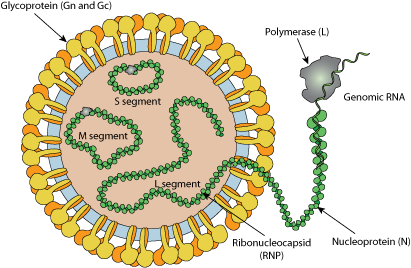Phlebovirus ~ ViralZone (original) (raw)
VIRION

Enveloped, spherical. Diameter from 80 to 120nm. Glycoproteins at the surface of the envelope are arranged on an icosahedral lattice, with T=12 symmetry.
GENOME
Segmented Negative-stranded RNA linear genome, L segment is about 6.4kb, M segment about 3.2kb and S segment about 1.7kb.
Encodes for six proteins.
GENE EXPRESSION
Transcription starts by viral RNA dependent RNA polymerase (L) binding to a promoter on each encapsidated segment, and is terminated by a strong hairpin sequence at the end of each gene. These are capped by L protein during synthesis using cap snatching , but are not polyadenylated.
S segment uses ambisense strategy to encode for several proteins: both genomic and antigenomic RNA are transcribed. The hairpin sequence is a stop polymerase signal which prevents ambisense transcription from producing dsRNA. M segment encodes for several polyproteins by leaky scanning, which are cleaved by host protease into Nsm-GN, Nsm, NSm',Gn and Gc proteins.
ENZYMES
REPLICATION
CYTOPLASMIC
- Virus attaches to host receptors though Gn-Gc glycoprotein dimer, and is endocytosed into vesicles in the host cell.
- Fusion of virus membrane with the vesicle membrane; ribonucleocapsid segments are released in the cytoplasm.
- Transcription, viral mRNAs are capped in the cytoplasm.
- Replication presumably starts when enough nucleoprotein is present to encapsidate neo-synthetized antigenomes and genomes.
- The ribonucleocapsids buds at Golgi apparatus, releasing the virion by exocytosis.